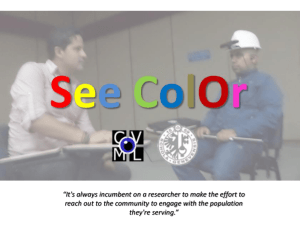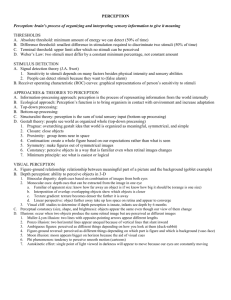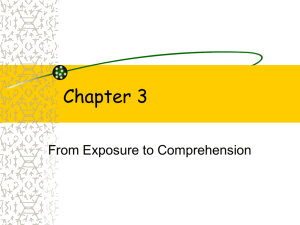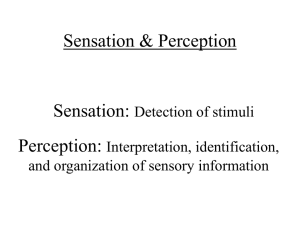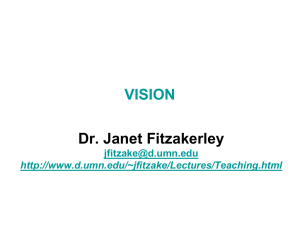Review
advertisement
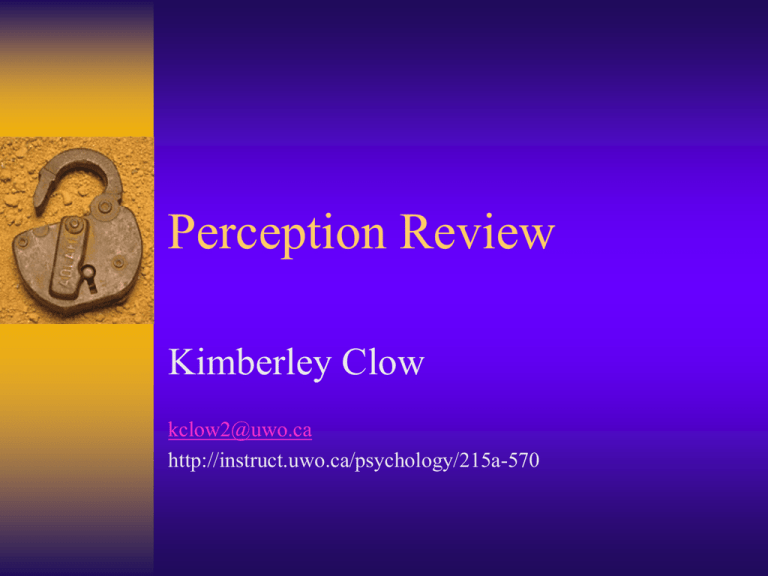
Perception Review Kimberley Clow kclow2@uwo.ca http://instruct.uwo.ca/psychology/215a-570 Final Exam Cumulative Final – Textbook chapters 10, 15, & 16 – All lectures (September-December) – 30-ish questions on info since test2 – 50-ish questions on test1 and test2 info 40% – Unless you missed or replace test1 or missed or replace test2 • Then it is 70% – Unless you missed or replaced BOTH tests • Then it is 100% Definitions Sensation – the process by which stimuli are registered in the receptors Perception – the conscious experience of objects and object relationships Psychophysics – The study of the relationship between physical stimuli in the world and the sensations about them that we experience Absolute Threshold – Boundary between detectable and undetectable stimuli Just Noticeable Difference – Minimum amount a stimulus must be changed to produce a noticeable difference Psychophysics What are we looking at? – What is detection? – What is discrimination? – What is scaling? – What is identification? Scaling – Indirect Scaling – Magnatude Estimation – Cross Modality Matching What are the methods of psychophysics? – Method of Constant Stimuli – Method of Limits – Staircase Method – Signal Detection Theory Weber’s Law Vision Cones – Colour vision – Acuity – Fovea Rods – Night vision – Periphery The Eye – Cornea – Lens – Retina – Blind spot Lateral Inhibition Focusing the Eye – Accommodation – Near vs. Far-sighted Receptive Fields Visual Pathway – Tectopulvinar – Geniculostriate Visual Cortex Areas – V1-V5 Colour Vision When do we see white? What is the Trichromatic Theory? What is the Opponent-Process Theory? What are the different forms of color blindness? – Which is most common? What is additive colour mixing? – Primaries? What is subtractive colour mixing? – Primaries? Hearing The frequency of a sound wave corresponds to what perceptual quality of sound? What is timbre? What is another name for the eardrum? What are those bones in the middle ear called? How does the auditory system code pitch? How do we locate sound? How do the different neurons respond? – Onset, Pauser, Chopper, Primary-like, Offset What are the auditory pathways? Describe the auditory cortex Speech Pronouncing vowels vs. consonants Define phonology, semantics, and syntax What do you know about formants? What is categorical perception? The McGurk Effect Phonemic Restoration Effect Pauses Speech Errors Aphasia – Broca’s; Wernicke’s Touch, Taste, & Smell Touch – 4 Receptor Types • Adapting & Receptive Fields – Somatosensory Cortex • Representation – Pain – Touch Acuity – Haptics Taste – 4 Papillae – Supertasters – Identifying tastes • Effects of smell Smell – Olfactory bulb • Cilia – Identification vs. Discrimination – Pheromones • McClintock Effect – Memory Depth Oculomotor – Accommodation – Convergence Pictorial Cues – – – – – – – Interposition Relative Size Familiar Size Atmospheric Haze Linear Perspective Texture Gradient Shading Motion Based Cues – Motion Parallax – Biological Motion – Kinetic Depth Effect Binocular Cues – Retinal Disparity • Crossed & Uncrossed • Diplopia • Horopter Perceiving Form Form defined by texture Pop-out effects Perceiving form – Change – Top down vs. bottom up processing – Figure-Ground Theories – Template Theories – Feature Theories • Pandemonium Model Gestalt Principles – Proximity – Similarity – Good Continuation – Symmetry – Closure – Subjective Contours Perceiving Objects Attention – Change Blindness – Cued Paradigm Theories – Recognition by Components – View-Based Recognition Is face perception special? – Prosopagnosia – Greebles Learning & Experience Development of the visual system – Acuity, contrast sensitivity, colour perception Methodologies – Fixating & Scanning, Reflexes, Preferential Looking, Habituation, Forced-Choice Preferential Looking Development of – Form, Motion, & Depth Perception – Monocular & Binocular Cues Experiences – Strabismus – Astigmatism – Monocular Deprivation Critical Periods Restored Vision – SB No Class Wednesday Study Hard! & Good Luck!!
